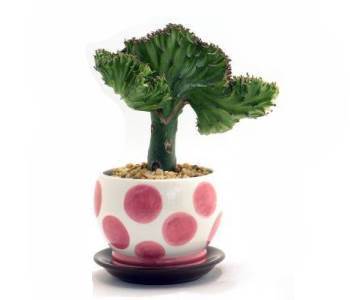Is it a cactus?: It's not a genuine cactus; it just gets the name based on similarities which is the stem (main trunk) and it is cared for in a similar way.
It's actually a African succulent from the Euphorbia genus and Euphorbiaceae family that has been mutated to create one plant type from two.
How it looks: It very much looks like coral reef with crinkled sort of cabbage leaves (green, white, yellow with pink, ruby or purple edges) and a green thick stem.
The coral plant may not be everyone's ideal looking plant, however, some growers love the unusual types and this is quite unique.
Easy to grow: A nice and easy plant for the indoor grower that does not need a lot of watering or re-potting, very often.
One of the main things not to do is over water it, which can cause plant death.
Poisonous: All parts of the Coral cactus are poisonous and should not be ingested by humans or animals. And, it produces a sap which should be cleaned off immediately to prevent skin irritation. After handling it's wise to wash your hands or use gloves.
Keeping the plant out of reach from the kids and pets (cat's & dog's) is advisable.
Facts
Origin:
Africa and then developed in Thailand to the Lactea crest.
Names:
Coral cactus (common). Eurphorbia lactea crest (botanical/scientific).
Max Growth (approx):
Height 9 in - 15 in.
Poisionous for pets:
Toxic to cats and dogs (see description).

Coral Cactus Care
Temperature:
The Coral likes it's sunshine and warm conditions which help it to grow and maintain's it's health.
A partially sunny spot and average temperatures of no lower than approximately 60°F (15°C) will suffice.
Light:
These do prefer good light conditions and sunlight, although it's best to provide them with partial sunlight and shade in high temperatures. This is the type of plant that grows lopsided if it only receives sunlight on one side, which is worth noting.
Watering:
Before watering the coral cactus check underneath the pot through the drainage holes to see if the roots are dry. If so then add some water. Do not water too often to prevent over watering, that can potentially kill it off.
Soil:
A cactus soil mix will be fine. The mix needs to be a type that is light and drains easily to prevent the roots from getting water logged.
Fertilizer:
Using fertiliser once each season is a good method, but not in the winter. A good succulent and cacti product bought will provide the correct instructions to follow.
Re-Potting:
Re-pot only when necessary (becomes pot bound, but that's unlikely). It may be safest to re-pot as soon as you get the Coral home in-case the mix, pot or both are not adequate.
Propagation:
These are propagated with cuttings taken in spring, which need to be dried out for a couple of weeks before potting (source; EwaterPlant Bangkok). Do remember that the sap from the Coral is poisonous, so take precautions (gloves - protective eye-wear).






